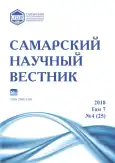Ectoparasites of the bats from karst caves of the nature reserve «Ichalkovsky Bor» (Nizhny Novgorod Region)
- Authors: Fadeeva G.A.1, Boryakova E.E.1
-
Affiliations:
- National Research Lobachevsky State University of Nizhny Novgorod
- Issue: Vol 7, No 4 (2018)
- Pages: 122-126
- Section: 03.02.00 – General Biology
- URL: https://journal-vniispk.ru/2309-4370/article/view/21863
- DOI: https://doi.org/10.17816/snv201874121
- ID: 21863
Cite item
Full Text
Abstract
The fauna of parasitic mites of bats from the karst caves in the region of the Volga Upland was studied in 2004–2005. Six species of bats such as Daubenton’s water bat, Brandt’s bat, whiskered bat, pond bat, northern bat and long-eared bat were examined. 18 species of arthropods were detected, among them there are gamasid mites (10 species) and harvest mites (2 species). Leptotrombidium russicum (Oud., 1902) and Myotrombicula sp. were found for the first time in Central Russia. Spinturnix acuminatus (Koch, 1836), Steatonyssus spinosus (Willmann, 1936), Steatonyssus periblepharus (Kolenati, 1858), Macronyssus flavus (Kolenati, 1856) turned out to be the main group of parasites in this study. As for the insects flies of the family Nycteribiidae and fleas of the family Ischnopsyllidae were found. The cluster analysis of ectoparasite fauna has showed that they are more or less evenly distributed among all members of mixed colonies of bats, while there is no violation of specificity in the choice of hosts. Low values of the Berger-Parker index marked a lack of competition between species, which indicates the stability of parasitic communities formed on bats in mixed colonies and in natural habitats. This fact indicates a complex relationship between the parasites in the community on the one hand, and long-term existence of the community on the other hand. This, in its turn, shows that in long-evolving communities competitive relationships between parasites are obliterated, which gives them stability. Herewith the bat colony is used as an integral whole, although some parasitic species prefer certain types of hosts.
Full Text
##article.viewOnOriginalSite##About the authors
Galina Anatolievna Fadeeva
National Research Lobachevsky State University of Nizhny Novgorod
Email: fadeevagal@mail.ru
candidate of biological sciences, associate professor of Botany and Zoology Department
Russian Federation, Nizhny NovgorodElena Evgenievna Boryakova
National Research Lobachevsky State University of Nizhny Novgorod
Author for correspondence.
Email: boryakova@mail.ru
candidate of biological sciences, associate professor of Botany and Zoology Department
Russian Federation, Nizhny NovgorodReferences
- Радовский Ф. Эволюция и адаптивная радиация у Gamasina, паразитов позвоночных // Паразитология. 1968. Т. 2, вып. 2. С. 124-135.
- Станюкович М.К. Гамазовые и аргазовые клещи рукокрылых Прибалтики и Ленинградской области // Паразитология. 1990. Т. 24, вып. 3. С. 193-200.
- Бобкова О.А. Клещи-эктопаразиты (Acari) рукокрылых (Chiroptera) восточной части Украины // Вестник зоологии. 2005. Т 39, № 2. С. 73-78.
- Орлова М.В., Капитонов В.И., Григорьев А.К., Орлов О.Л. Эктопаразиты рукокрылых Удмуртской республики // Вестник Удмуртского ун-та. Серия «Биология: науки о Земле». 2011. Вып. 2. С. 134-138.
- Орлова М.В. Фауна и экология эктопаразитов рукокрылых Урала: автореф. дис. … канд. биол. наук. Екатеринбург, 2013. 20 с.
- Орлова М.В., Чистяков Д.В., Орлов О.Л., Крюгер Ф., Кшнясев И.А. Фауна эктопаразитов прудовой ночницы Myotis dasicneme (Boie, 1825) (Chiroptera, Vespertilionidae) Северной Евразии // Вестник Санкт-Петербургского университета. Серия 3: Биология. 2014. Вып. 1. С. 24-37.
- Seneviratne S., Fernando H., Udagama-Randeniya P. Host specificity in bat ectoparasites: A natural experiment // International Journal for Parasitology. 2009. Vol. 39, is. 9. P. 995-1002.
- Hassan V., Zakkyeh T., Mozafar S. et al. Ectoparasites of lesser mouse eared bat, Myotis blythii from Kermanshah Iran // Asian Pacific Journal of Tropical Medicine. 2010. Vol. 3, is. 5. P. 371-373.
- Станюкович М.К. Гамазовые клещи (Parasitiformes, Gamasina) сем. Macronyssidae Oud., 1936 России и сопредельных стран (бывшего СССР) // Проблемы современной паразитологии: II междунар. конф. и III съезд Паразитологического общества при РАН. Петрозаводск, 6-12 октября 2003 г. СПб.: Зоол. ин-т РАН, 2003. С. 123.
- Емчук Е.М. Эпизоотологическое значение летучих мышей и их эктопаразитов // Проблемы паразитологии. Киев, 1963. С. 341-343.
- Турянин И.И. Состав позвоночных животных - прокормителей клещей рода Ixodes в Советских Карпатах // Проблемы паразитологии. Киев, 1963. С. 402-404.
- Бобкова О.А. Распространение иксодоидных клещей (Ixodoidea, Parasitiformes) - эктопаразитов рукокрылых (Chiroptera) в Украине // Вестник зоологии. 2003. Т. 37, вып. 6. С. 23-28.
- Балашов Ю.С. Паразито-хозяинные отношения членистоногих с наземными позвоночными. Л.: Наука, 1982. 320 с.
- Кузякин А.П. Летучие мыши (систематика, образ жизни и польза для сельского и лесного хозяйства). М.: Советская наука, 1950. 444 с.
- Никитина Н.А., Кулик И.Л., Дубровский Ю.А. Медицинская териология: Грызуны, хищные, рукокрылые / отв. ред. В.В. Кучерук. М.: Наука, 1989. 269 с.
- Stanyukovich M. Keys to the gamasid mites (Acari, Parasitiformes, Mesostigmata, Macronyssoidea et Laelaptidae) parasitizing bats (Mammalia, Chiroptera) from Russia and adjacent countries // Rudolstädter nat. hist. 1997. Schr. 7. P. 13-46.
- Определитель насекомых Европейской части СССР. Т. 5, ч. 2. Л., 1970. 946 с.
- Трухачева Н.В. Математическая статистика в медико-биологических исследованиях с применением пакета Statistica. М.: ГЭОТАР-Медиа, 2012. 384 с.
- Станков С.С. Очерки физической географии Горьковской области. Горький: Горьк. обл. гос. изд-во, 1951. 296 с.
- Фридман Ф.М., Баканина Ф.М., Бакка А.И., Бакка С.В. Уникальный уголок горно-таежного ландшафта в центре русской равнины // Природа Поволжья. Нижний Новгород, 1997. С. 183-191.
- Мэгарран Э. Экологическое разнообразие и его измерение. М.: Мир, 1992. 184 с.
Supplementary files







